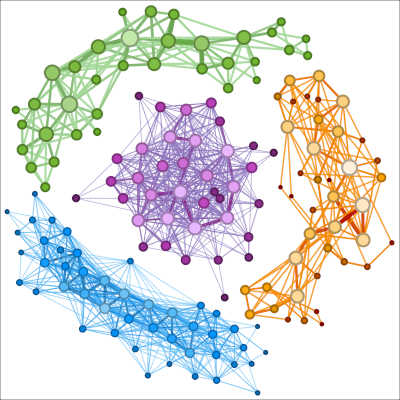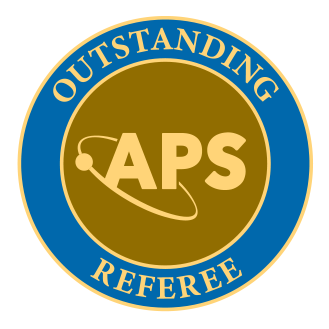

EDITORS' SUGGESTION
Optimal probe states for single-mode quantum target detection in arbitrary object reflectivity
Wei-Ming Chen and Pin-Ju Tsai
Phys. Rev. Research 6, 023084 (2024)This article uses an optimization algorithm to obtain single-mode Optical Probe States and provides a physical interpretation of these.

EDITORS' SUGGESTION
Single-shot measurement of photonic topological invariant
Nathan Roberts, Guido Baardink, Anton Souslov, and Peter J. Mosley
Phys. Rev. Research 6, L022010 (2024)Characterizing topological devices can be a lengthy and difficult process. In an effort to simplify topological characterization, a single-shot method for observing topological winding numbers with only a broadband light source is introduced and demonstrated.

EDITORS' SUGGESTION
Modulation instability and wavenumber bandgap breathers in a time layered phononic lattice
Christopher Chong, Brian Kim, Evelyn Wallace, and Chiara Daraio
Phys. Rev. Research 6, 023045 (2024)Structures that are localized in time and periodic in space are experimentally observed in a phononic lattice. These structures are analogous to the famous “breathers,” but with the role of time and space switched.

EDITORS' SUGGESTION
Topological dualities via tensor networks
C. Wille, J. Eisert, and A. Altland
Phys. Rev. Research 6, 013302 (2024)Dualities between three paradigmatic models in condensed-matter physics (the two-dimensional classical Ising model, the toric code, and a class D topological superconductor) are explored from a tensor network perspective. Being exact and explicit in nature, the approach allows for the translation of properties of the three different systems on a microscopic level and for the linking of nontrivial phenomena such as topological excitations, edge modes, and disorder operators.

EDITORS' SUGGESTION
Plasmonic vortices host magnetoelectric interactions
Atreyie Ghosh et al.
Phys. Rev. Research 6, 013163 (2024)Plasmonic vortices are found to host pseudoscalar 𝙀∙𝘽 fields that are odd under parity 𝒫 and time 𝒯 inversion, but even under the joint 𝒫𝒯 symmetry, enabling them to drive the magnetoelectric response and act as a source of the axion field.

EDITORS' SUGGESTION
Information content of note transitions in the music of J. S. Bach
Suman Kulkarni, Sophia U. David, Christopher W. Lynn, and Dani S. Bassett
Phys. Rev. Research 6, 013136 (2024)A study combines methods from network science, information theory, and cognitive science to examine the information present in note transitions within music composed by J. S. Bach. It identifies and explains differences in information content across various compositional forms based on their network structure.




LETTER
Hayden-Preskill recovery in Hamiltonian systems
Yoshifumi Nakata and Masaki Tezuka
Phys. Rev. Research 6, L022021 (2024)

LETTER
Demonstrating quantum computation for quasiparticle band structures
Takahiro Ohgoe et al.
Phys. Rev. Research 6, L022022 (2024)


LETTER
Epidemic criticality in temporal networks
Chao-Ran Cai, Yuan-Yuan Nie, and Petter Holme
Phys. Rev. Research 6, L022017 (2024)

LETTER
Active jamming at criticality
Shalabh K. Anand, Chiu Fan Lee, and Thibault Bertrand
Phys. Rev. Research 6, L022018 (2024)

LETTER
Stacked tree construction for free-fermion projected entangled pair states
Yuman He, Kangle Li, Yanbai Zhang, and Hoi Chun Po
Phys. Rev. Research 6, L022016 (2024)

LETTER
Vertical velocity of a small sphere in a sheared granular bed
Song Gao (高颂), Julio M. Ottino, Richard M. Lueptow, and Paul B. Umbanhowar
Phys. Rev. Research 6, L022015 (2024)



LETTER
Bloch-Landau-Zener oscillations in a quasi-periodic potential
Henrique C. Prates and Vladimir V. Konotop
Phys. Rev. Research 6, L022011 (2024)


LETTER
Rectification and nonlinear Hall effect by fluctuating finite-momentum Cooper pairs
Akito Daido and Youichi Yanase
Phys. Rev. Research 6, L022009 (2024)

LETTER
Failure of an effective stress approach in polydisperse wet granular materials
David Cantor, Emilien Azéma, and Carlos Ovalle
Phys. Rev. Research 6, L022008 (2024)

LETTER
Charge-order melting in the one-dimensional Edwards model
Florian Lange, Gerhard Wellein, and Holger Fehske
Phys. Rev. Research 6, L022007 (2024)


LETTER
Chiral excitations and the intermediate-field regime in the Kitaev magnet
Anuja Sahasrabudhe et al.
Phys. Rev. Research 6, L022005 (2024)


LETTER
N-body antibunching in a degenerate Fermi gas of atoms
Kieran F. Thomas et al.
Phys. Rev. Research 6, L022003 (2024)

LETTER
Resonant excitation of plasma waves in a plasma channel
A. J. Ross et al.
Phys. Rev. Research 6, L022001 (2024)

LETTER
Tuning the Josephson diode response with an ac current
Rubén Seoane Souto et al.
Phys. Rev. Research 6, L022002 (2024)

LETTER
Defect-populated configurations in nematic solid tori and cylinders
Javier Rojo-González et al.
Phys. Rev. Research 6, L012065 (2024)

LETTER
Thermalization universality-class transition induced by Anderson localization
Weihua Zhang, Gabriel M. Lando, Barbara Dietz, and Sergej Flach
Phys. Rev. Research 6, L012064 (2024)

LETTER
Higher-order quantum transformations of Hamiltonian dynamics
Tatsuki Odake, Hlér Kristjánsson, Akihito Soeda, and Mio Murao
Phys. Rev. Research 6, L012063 (2024)

LETTER
Nonlocality of Majorana bound states revealed by electron waiting times in a topological Andreev interferometer
Paramita Dutta, Jorge Cayao, Annica M. Black-Schaffer, and Pablo Burset
Phys. Rev. Research 6, L012062 (2024)

LETTER
Implications of pulsar timing array data for scalar-induced gravitational waves and primordial black holes: Primordial non-Gaussianity considered
Sai Wang, Zhi-Chao Zhao, Jun-Peng Li, and Qing-Hua Zhu
Phys. Rev. Research 6, L012060 (2024)


LETTER
Crossed nonlinear dynamical Hall effect in twisted bilayers
Cong Chen, Dawei Zhai, Cong Xiao, and Wang Yao
Phys. Rev. Research 6, L012059 (2024)


LETTER
Resonance triplet dynamics in the quenched unitary Bose gas
J. van de Kraats, D. J. M. Ahmed-Braun, V. E. Colussi, and S. J. J. M. F. Kokkelmans
Phys. Rev. Research 6, L012056 (2024)

LETTER
Exceptional ring of the buoyancy instability in stars
Armand Leclerc et al.
Phys. Rev. Research 6, L012055 (2024)
Now open for Submissions!
SUBMIT YOUR ARTICLEEmail Alerts
Sign up to receive regular email alerts from Physical Review Research
Sign Up


Announcements
APS Announces Outstanding Referees for 2024March 1, 2024
APS Partners with Research4LifeDecember 15, 2023

Scope
Physical Review Research welcomes papers from the full spectrum of research topics of interest to the physics community. Research coverage in the journal comprises: fundamental and applied; theoretical and experimental, including technical and methodological advances; and interdisciplinary and newly emerging areas.
